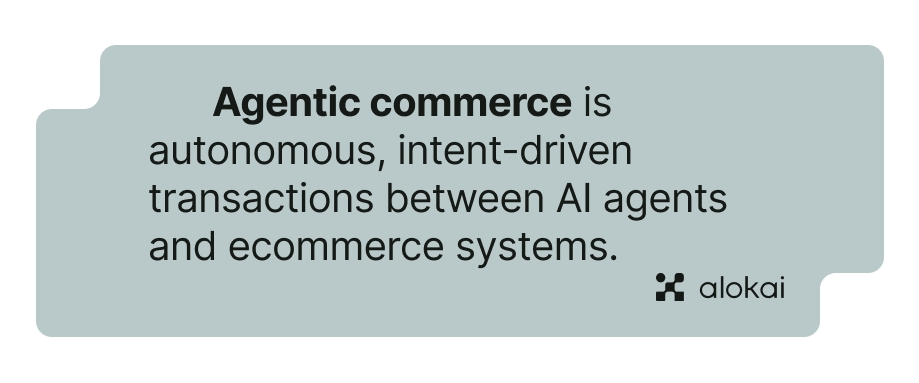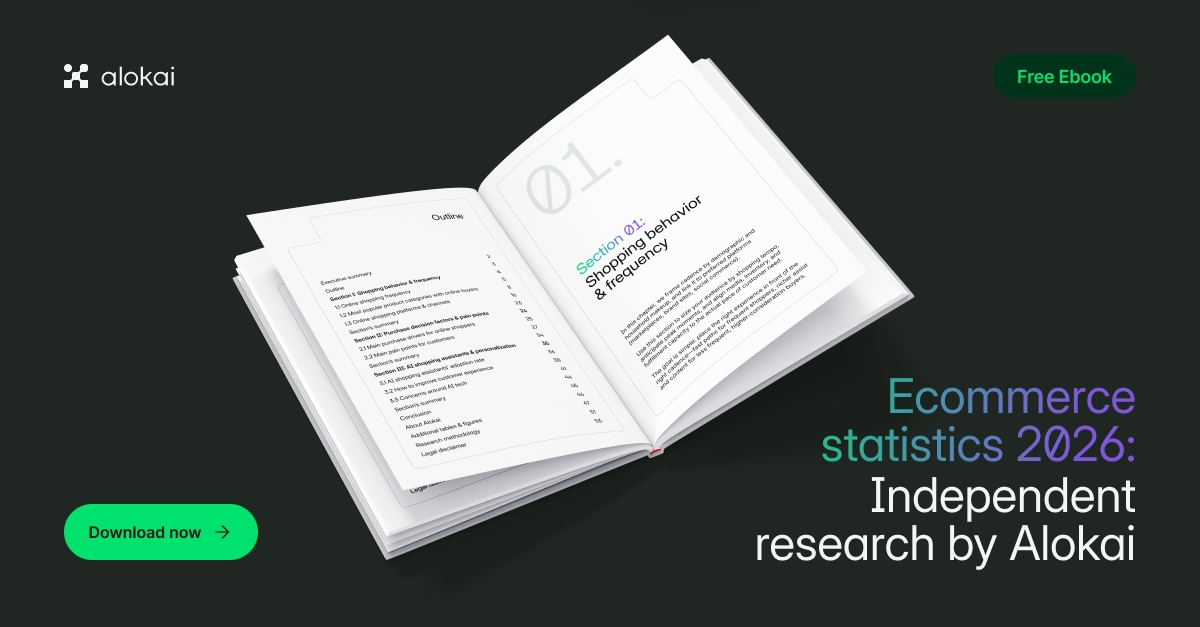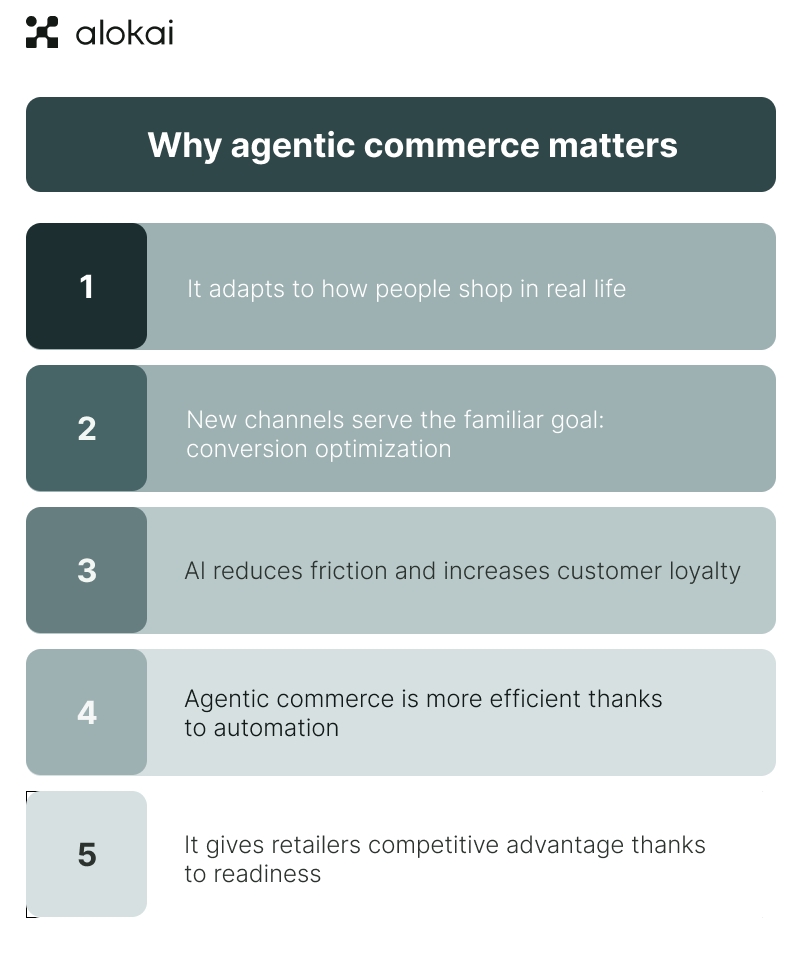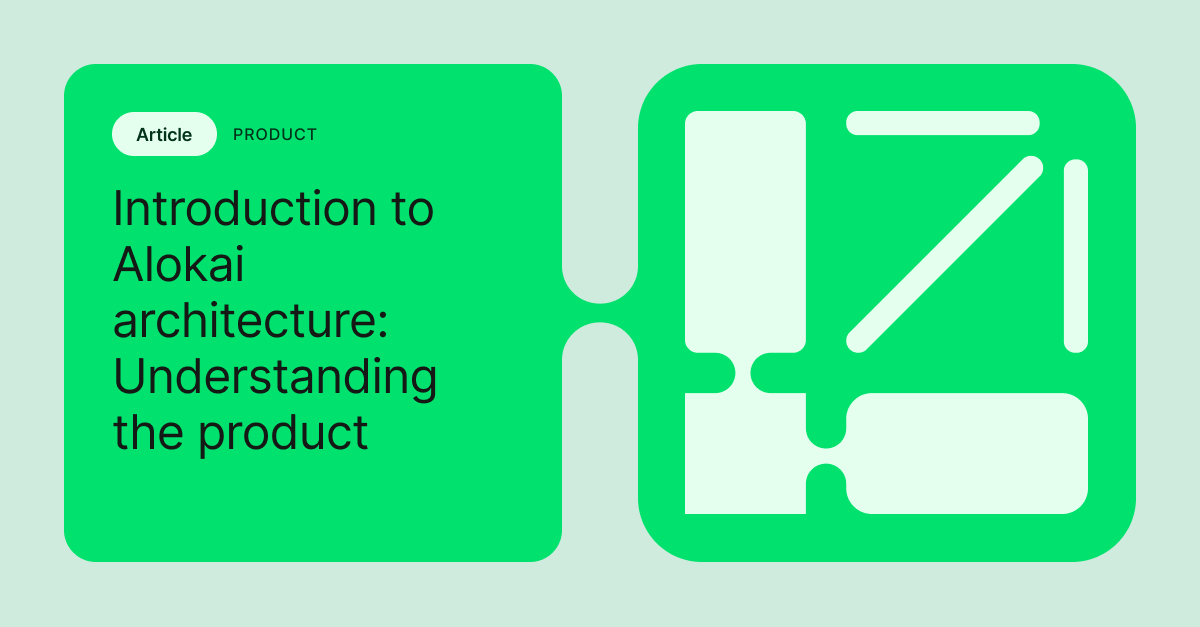Imagine a world where your online store doesn’t wait for customers to browse — it acts on their intent. A customer says, “Order my usual running shoes, but this time in blue,” and their AI assistant handles the rest — from product discovery to payment — directly with your storefront’s APIs.
That’s agentic commerce: a model in which autonomous AI-powered agents act on behalf of customers or with minimal human input, and merchants prepare their systems to serve those agents reliably, securely, and contextually.
It’s the next evolution of ecommerce — and it’s already reshaping how storefronts, payment providers, and data layers interact.
Key takeaways
- Agentic commerce = AI agents executing purchases on users’ behalf.
- Implementation depends on structured data, composable architecture, and secure APIs.
- GEO and structured content replace traditional SEO as discovery models shift.
- Early adopters will own visibility in AI-driven shopping ecosystems.
What is agentic commerce? The definition
Agentic commerce describes transactions initiated, negotiated, and completed by autonomous software agents — not humans directly. These agents interpret natural language prompts, understand preferences, and perform multi-step actions across digital storefronts.
In practical terms, it means:
A customer agent (like an AI assistant embedded in ChatGPT, a phone OS, or a retail app) identifies what the user wants
A merchant agent exposes structured data — inventory, pricing, delivery options — via APIs and standardized schemas
- The two agents communicate directly to complete a purchase, often using
This isn’t science fiction — Visa, Mastercard, OpenAI, and major commerce platforms are already experimenting with these frameworks.

How agentic commerce works: from intent to transaction
Let’s break down the flow behind every agentic transaction:
- Intent capture
- Discovery and reasoning
- Negotiation and personalization
- Secure checkout
- Post-purchase learning

Agentic commerce vs traditional ecommerce
Agentic AI reimagines traditional ecommerce operations, bringing a fundamental change to customer relationships and buyer's experience:
Traditional ecommerce | Agentic commerce |
Users browse sites manually and click “buy.” | AI agents interpret intent and act automatically. |
UX and visual design drive conversion. | Structured data and APIs drive discoverability. |
Focus on “conversion rate optimization.” | Focus on machine-to-machine readiness. |
SEO targets human queries. | GEO (Generative Engine Optimization) targets AI prompts. |
Personalization relies on cookies and sessions. | Personalization happens through autonomous agents and real-time context exchange. |
The shift is profound: instead of designing for human clicks, brands will design for AI comprehension.
From generative AI to agentic AI: How we got here
The rise of generative AI — systems that create content, text, or imagery in response to prompts — laid the foundation for the next leap: agentic AI, which doesn’t just generate information but acts on it.
Generative models like GPT-4, Claude, or Gemini taught machines to understand context, intent, and natural language. That made ecommerce more conversational: customers could describe what they wanted in their own words and get curated recommendations.
But generative AI had one major limitation — it stopped at suggestion. It could recommend a product or summarize a review, but it couldn’t complete the purchase or coordinate actions across systems.
Agentic AI fills that gap.
Agentic systems combine generative reasoning with goal-oriented execution. They use APIs, logic frameworks, and payment protocols to make real decisions — searching, comparing, negotiating, and transacting — not just describing results.
In short:
- GenAI
- Agentic AI
Together, they form the two halves of the modern commerce brain:
- The
- The
For brands, this means the transition from content optimization to commerce automation. Your product data, descriptions, and brand assets that once fed search engines now feed agents that both explain and execute on behalf of users.
Agentic AI, therefore, isn’t replacing generative AI — it’s built on top of it.
Why agentic commerce matters

Agentic commerce introduces efficiency and intelligence at every layer of digital retail. Here’s why it’s such a big deal:
1. Commerce adapts to how people actually shop
We’re moving from search to conversation. Customers no longer type keywords — they describe outcomes. Agents handle the rest.
If your store can’t “speak” in the same structured, API-friendly language, it becomes invisible to the new AI layer.
2. New channels, same goal: conversion
Commerce will expand beyond websites — into AI assistants, car dashboards, smart speakers, and AR environments.
Agentic commerce ensures your catalog, pricing, and fulfillment data are accessible in those new contexts.
3. Reduced friction and higher loyalty
Agents remember preferences and negotiate automatically. Merchants who expose loyalty data and flexible pricing rules through APIs can build persistent, frictionless relationships.
4. Efficiency through automation
When much of discovery, comparison, and purchase happen between agents, human effort drops — both for the buyer and for internal teams managing storefront logic.
5. Competitive advantage through readiness
Just as early SEO adopters dominated web search, early GEO-ready brands will dominate AI-driven shopping. Structured data, accessible APIs, and clear trust protocols are the new differentiators.
The technology behind agentic commerce
For agentic commerce to work reliably, multiple systems need to talk to each other securely and contextually. The tech stack usually includes:
Structured product data
- Use schemas compatible with
- Maintain consistent taxonomy, attributes, and availability status.
- Sync updates in real time — stale data breaks agent trust.
Unified Data Layer (UDL)
A UDL bridges your frontend, backend, and external systems — ensuring agents can query consistent information about pricing, inventory, and personalization. It becomes the single source of truth for agentic communication.
Frontend as a Service (FEaaS)
Agentic commerce needs flexible frontends capable of responding dynamically to agent or user requests. FEaaS solutions like Alokai’s enable modular, API-based frontends ready for both human and agentic interfaces.
Middleware and orchestration
Agentic commerce often involves multiple integrations — CRM, PIM, payment gateways, logistics. Middleware layers handle authentication, rate limiting, and schema mapping between systems.
Secure payments & identity
Protocols like OAuth 2.0 or Passkeys ensure delegated trust — the AI agent can complete a transaction on the user’s behalf without revealing credentials.
How to implement agentic commerce today
You don’t need to rebuild your stack. You need to make it agent-ready. Here’s a step-by-step roadmap.
1. Standardize and expose product data
- Use structured schemas (JSON-LD, Schema.org/Product, or ACP)
- Include metadata like energy rating, materials, or delivery ETA — these become agent decision factors.
- Keep availability, price, and variant data real-time.
2. Connect via a middleware or Unified Data Layer
Adopt a middleware architecture that consolidates all data sources. This makes it easy to create agent-friendly APIs without overhauling your backend.
If you’re already composable, you’re halfway there — your modular architecture supports this evolution.
3. Prepare your frontend for both humans and agents
- Make content
- Keep your storefront adaptable — modular, composable, fast.
- Maintain clear human UX but design for machine parsing.
4. Monitor and optimize for GEO (Generative Engine Optimization)
- Create FAQs and clear question–answer sections.
- Mark up answers with FAQ schema.
- Track which queries bring AI-generated citations of your brand.
Real-world agentic commerce examples and early use cases
Agentic commerce is already moving from concept to practice, transforming how consumers purchase products and how brands think about digital commerce. Below are examples showing how shopping agents and autonomous systems are redefining what online shopping means — across both physical and digital goods.
Conversational shopping agents as personal shoppers
Imagine having a personal shopper who never sleeps. Modern shopping agents built into ChatGPT, Gemini, and voice assistants can interpret natural language prompts like “Find a minimalist office chair under $300 that ships today.”
They browse merchant APIs, compare models, verify stock, and initiate instant checkout — no forms, no friction, just results.
This evolution marks a shift in digital commerce from search-based discovery to goal-oriented delegation.
Seamless shopping for physical and digital goods
Agentic systems don’t distinguish between physical and digital goods.
A customer could ask an assistant to “Buy a new ebook on UX design and the matching notebook set” — the agent completes both in one flow.
By integrating multiple APIs and tokenized payment flows, brands enable agents to handle diverse product types, from tangible inventory to software subscriptions, through a unified experience.
Automated reorders and trusted payment credentials
For repeat purchases, shopping agents can securely manage payment credentials and preferences on behalf of the user.
Once consent is granted, the system can purchase products like groceries or app credits automatically, adjusting based on usage or availability.
Instant checkout completes the transaction seamlessly, leveraging delegated payment tokens — never exposing sensitive data.
Contextual bundling and adaptive recommendations
Just as a great personal shopper anticipates needs, agentic systems learn from purchase history and context.
When a user orders a laptop, the agent may add accessories, warranties, or software licenses that complement the intent.
This proactive upselling transforms passive online shopping into intelligent engagement — one that feels curated, not pushed.
Frictionless commerce as the new standard
Agentic commerce is poised to redefine digital commerce. With secure payment credentials, instant checkout, and conversational decision-making, shopping becomes invisible — a background process guided by trust and context rather than clicks and forms.
For merchants, it means lower abandonment rates and higher lifetime value; for consumers, it means every interaction feels as natural as asking a personal shopper for advice.
Challenges and guardrails
Agentic commerce brings new responsibilities and complexity:
Trust, identity, and fraud
- How to verify that an agent truly represents a user?
- Delegated scopes must have limits, timeouts, and revocation
- Audit trails are required to resolve disputes
Brand control & presentation
If agents mediate discovery, brands need to ensure their story, imagery, and differentiation survive within structured data rather than just visual design.
Transparency & explainability
Agents should explain why they chose a product (e.g. “I chose this camera because it had the best low-light reviews + free shipping”) so users feel in control.
Failover & fallback UI
If agent logic fails (no product matches, API down, conflicting constraints), the user must be able to take over manually.
Ethical data use
Agents use sensitive data (purchase history, preferences). Consent, privacy rules, and data governance are mandatory.
Metrics & analytics shift
Traditional KPIs (page views, bounce rates) are less relevant. Focus shifts to:
- Intent satisfaction rate
- Agent-to-store success rate
- Queries per transaction
- Clarification depth
- Value uplift (agent-enabled incremental lift)
Alokai Compass: bringing agentic commerce to your storefront
To make this vision concrete, meet Alokai Compass — the AI storefront agent built to power truly adaptive, intent-first commerce.
What is Compass?
Compass isn’t just a chatbot — it’s a framework that blends seamlessly into your storefront UI and guides users (or their agents) through discovery, comparison, explanation, and reorder flows.
Key highlights:
- Personalized discovery
- Smart comparisons
- Contextual explanations
- Minimal UI disruption
- Reorder support
- Agentic architecture
- Multichannel by design
The future: from composable to agentic
Composable commerce freed brands from monoliths. Agentic commerce frees customers from interfaces.
The next frontier is not designing for screens — it’s designing for understanding.
Brands that prepare now — with structured data, unified APIs, and adaptive frontends — will be the first to be discovered, transacted with, and trusted by intelligent agents.













